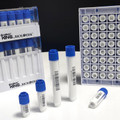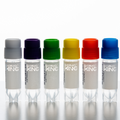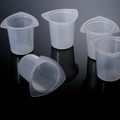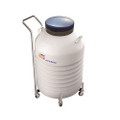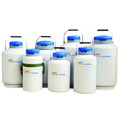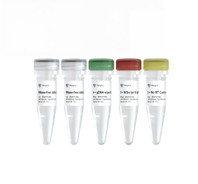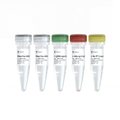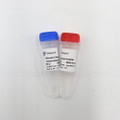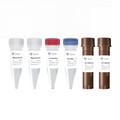 Loading... Please wait...
Loading... Please wait...Product Description
Product Introduction
HiScript III RT SuperMix for qPCR (+gDNA wiper) is an upgraded version of HiScript II Q RT SuperMix for qPCR (+gDNA wiper), including HiScript III Reverse Transcriptase, a new generation of reverse transcriptase with optimized Buffer. This kit further improves the efficiency of cDNA synthesis, and is suitable for two-step qRT-PCR detection. The 4 × gDNA wiper Mix in the kit can remove residual genomic DNA from the RNA template, ensuring more reliable quantitative results. It simplifies qPCR primer design without the need of spanning exon junction to design primers; 5 × HiScript III qRT SuperMix contains all components required for the reverse transcription reaction and it can be started rapidly after the addition of template RNA and RNase-free ddH 2 O, and the gDNA wiper is terminated to ensure the integrity of the cDNA. It is compatible with dye-based and probe-based qPCR, enabling high-performance gene expression analysis.
Citation
Components

Storage
Store at -30~-15℃ for up to 12 months, and transport at ≤℃.
FAQ
Q1: How to evaluate RNA quality?
A1: RNA quality is assessed in two aspects:
(1) RNA integrity. Verify RNA integrity by agarose gel electrophoresis. For eukaryotes, the intact total RNA yields three clear bands: 28S, 18S, and 5S (in descending order of molecular weight). The intensity of 28S is twice that of 18S. If the three bands are visible but blurred or diffused, it means that the RNA is partially degraded; in this case, reverse transcription should be performed as soon as possible with a higher template input amount. If there is only a low-molecular-weight band or no band, it means that the RNA is completely degraded; in this case, please extract new RNAs.
(2) RNA purity. RNA purity can be determined by the OD260/280 and OD260/230 ratios. The ratios within the range of 1.8 – 2.1 indicate high purity.
Note: Use 1% agarose gel and run at 210 V for 10 - 12 minutes. The RNA added with loading buffer can be loaded into a PCR system for denaturation at 70°C for 2 minutes before electrophoresis, which gives nicer RNA bands that can better reflect RNA integrity.
Q2: How to select primers for reverse transcription?
A2: There are three types of primers for reverse transcription:
(1) Random primers: Randomly binds to all RNA regions, and suitable for reverse transcription of all RNA types, including rRNA, mRNA, and tRNA.
(2) Oligo dT: Suitable for RNAs with poly(A) tails (The prokaryotic RNAs, eukaryotic rRNAs, and tRNAs do not contain poly(A) tails). Since Oligo dT binds to poly(A) tails, the RNA sample should be of high quality, as even minor degradation will substantially reduce the synthesis of full-length cDNAs.
(3) Gene-specific primers: Complementary to the template sequence, and suitable for reverse transcription of genes with known sequences.
Rationale for primer selection: If cDNAs will be used for PCR amplification of long fragments, use Oligo dT or gene-specific primers instead of random primers because random binding of random primers will yield short cDNA fragments. If cDNAs will be used for qPCR, use a mixture of Oligo dT and random primers to avoid preferential amplification of the 3' end.
Q3: Precautions when loading samples for reverse transcription:
A3: (1) 4 × gDNA wiper Mix, 5 × HiScript III qRT SμperMix, and 5 × No RT Control Mix contain high concentrations of glycerol. Briefly centrifuge to collect the mix at the bottom of the tube, and mix well by gently pipetting up and down before taking an accurate amount.
(2) Add no more than 1 µg of total RNA to a 20 μl reverse transcription system. If the expression of the target gene is low, add 5 µg of total RNA at most. Otherwise, excessive RNAs may make the cDNA (the reverse transcription product) concentration exceed the linear range of subsequent qPCR.
(3) Reverse transcription can be performed without genome removal. However, do not use 4 × gDNA wiper Mix with kits that do not contain genome removal modules (such as R222), because the Mix of these kits does not contain components that can stop the reaction with gDNA wiper, which may affect cDNA stability.
Q4: Can the reverse transcription efficiency be determined by measuring the cDNA concentration in the reverse transcription product?
A4: No. The reverse transcription product is a mixture that contains not only the product cDNA, but also buffer, reverse transcriptase, primers, non-transcribed template RNAs, and tRNAs and rRNAs from total RNA. All of these substances in the mixture may interfere with concentration measurement. Thus, the true cDNA yield cannot be determined. Since reverse transcription yields cDNA of varying lengths, the cDNAs cannot be purified, or short cDNAs will be lost.
Q5: Should cDNA templates be diluted? What's the dilution factor for qPCR?
A5: There is no reference dilution factor. In general, the Ct value increases by 3.3 with each 10-fold dilute solution of cDNA. Plan dilutions based on this rule. Perform qPCR using cDNA stock solution, 10-fold dilute solution, and 100-fold dilute solution as templates, and choose a dilution factor that gives a Ct value within the range of 18-28 based on the above rule. Alternatively, refer to the dilution factor of the previously used kits.
Note: When using the cDNA stock solution for testing, the input amount should not exceed 1/10 of the qPCR system, as the cDNA contains many components that inhibit qPCR and may hamper qPCR at large volumes.
Q6: Can the reverse transcription kit be applicable for lncRNAs and cirRNAs?
A6: Yes. The reverse transcription steps are similar to those for common RNAs. However, since lncRNAs are long, pre-denaturation at 65°C for 5 minutes is recommended before the genome removal step to unwind the secondary structure before reverse transcription. Not all lncRNAs have poly(A) tails, so the reverse transcription kit can be combined with both random primers and Oligo dT primers or only random primers, but it cannot be combined with Oligo dT primers alone.
The cirRNAs are closed-loop structures with no poly(A) tails, so only random primers are added for reverse transcription. The cirRNAs come in a wide range of sizes. For long cirRNAs, pre-denature them in the same manner as the lncRNAs. For cirRNAs of normal lengths, follow the normal procedures.
General tips for primer selection:
mRNA: random primers + Oligo dT; random primers; Oligo dT; gene-specific primers (GSPs);
cirRNA: random primers; GSPs;
lncRNA: random primers + Oligo dT; random primers; GSPs. Pre-denature lncRNAs before reverse transcription.
Q7: What are the advantages of the third-generation reverse transcription product over the second-generation one?
A7: (1) Lower Ct values (by 1 - 2 cycles) than second-generation products.
(2) High reverse transcription efficiency for degraded RNAs; works with RNAs with Rin = 2.5;
(3) High reverse transcription efficiency with a high RNA template input (1–5 μg) amount;
(4) High tolerance to common impurities, such as ethanol, isopropanol, phenols, and guanidinium isothiocyanate (introduced in RNA extraction).


